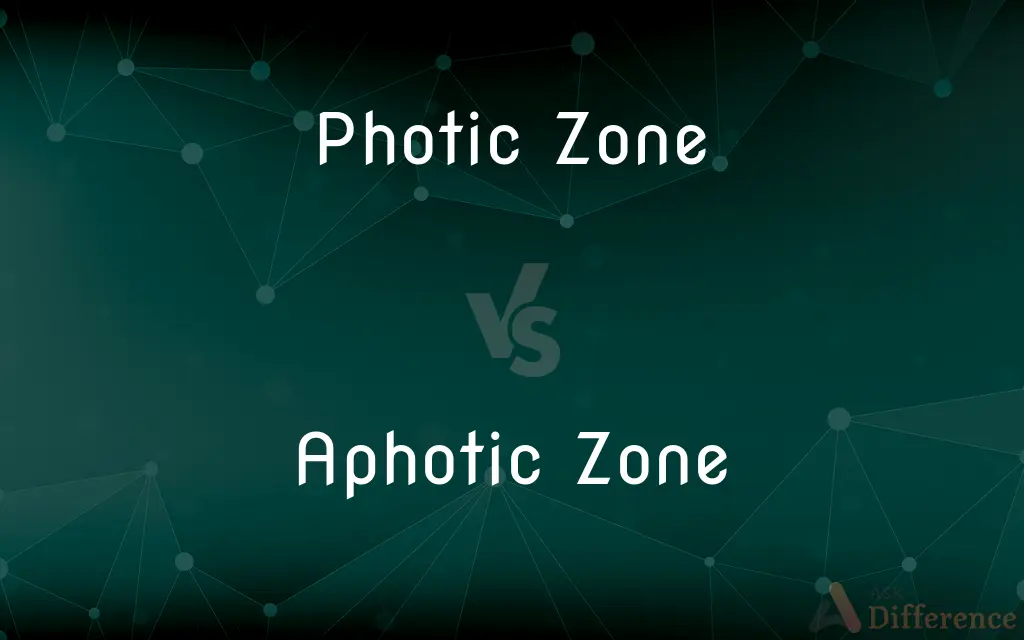Photic Zone vs. Aphotic Zone — What's the Difference?
By Tayyaba Rehman — Published on January 10, 2024
The photic zone is the upper layer of water in an ocean or lake where sunlight penetrates, enabling photosynthesis, while the aphotic zone is deeper, receiving little to no light.

Difference Between Photic Zone and Aphotic Zone
Table of Contents
ADVERTISEMENT
Key Differences
The photic zone is the sunlit upper layer of water bodies like oceans, seas, and lakes, where sunlight can penetrate and is sufficient for photosynthesis. This zone typically extends from the surface to a depth where light intensity falls to about 1% of its surface value. In contrast, the aphotic zone lies beneath the photic zone and is characterized by a lack of sufficient light for photosynthesis.
In the photic zone, the abundance of light supports a wide variety of marine life, including phytoplankton, which forms the base of the aquatic food web. This zone is crucial for the growth of most marine plants and for coral reefs. The aphotic zone, however, has significantly less biological activity due to the absence of light. Organisms in this zone either depend on organic matter drifting down from the photic zone or are adapted to the dark conditions.
The depth of the photic zone can vary depending on water clarity and the intensity of sunlight. In clear waters, it may extend down to about 200 meters, while in more turbid waters, it can be much shallower. The aphotic zone starts where the photic zone ends and extends to the ocean floor, including the deep oceanic trenches.
The photic zone is vital for the global carbon cycle as it is where most of the ocean's primary productivity occurs through photosynthesis. The aphotic zone, while less productive, is home to unique ecosystems such as deep-sea hydrothermal vents that host specialized life forms.
The differences in light availability in these zones also influence human activities. The photic zone is more accessible for activities like fishing, diving, and scientific research, whereas the aphotic zone remains largely unexplored and is studied mostly through deep-sea expeditions and remotely operated vehicles.
ADVERTISEMENT
Comparison Chart
Light Availability
Receives sufficient sunlight
Little to no sunlight
Depth Range
Surface to about 200 meters
Below the photic zone to the ocean floor
Biological Activity
High, supports photosynthesis
Less, depends on matter from above or specialized adaptations
Importance
Primary productivity, marine ecosystems
Unique deep-sea ecosystems
Human Accessibility
More accessible for activities
Less explored, studied with specialized equipment
Compare with Definitions
Photic Zone
Sunlit Upper Layer: The surface layer where sunlight penetrates.
Coral reefs thrive in the photic zone due to ample sunlight.
Aphotic Zone
Lacks Sufficient Sunlight: Too deep for sunlight to reach.
The aphotic zone is a dark environment with no photosynthesis.
Photic Zone
Abundant Marine Life: Hosts diverse marine organisms.
The photic zone is bustling with fish, plants, and other sea life.
Aphotic Zone
Dependent on Organic Matter from Above: Relies on falling detritus.
Creatures in the aphotic zone often feed on materials sinking from the photic zone.
Photic Zone
Supports Photosynthesis: Enables growth of marine plants.
Phytoplankton in the photic zone are crucial for the marine food web.
Aphotic Zone
Begins Where Photic Zone Ends: Extends to the ocean floor.
Many deep-sea creatures inhabit the aphotic zone.
Photic Zone
Varies with Water Clarity: Depth depends on water transparency.
In clear tropical waters, the photic zone extends deeper.
Aphotic Zone
Deep Ocean Ecosystems: Hosts unique life forms.
Bioluminescent organisms are common in the aphotic zone.
Photic Zone
Primary Productivity Area: Key for the global carbon cycle.
The photic zone plays a vital role in carbon dioxide absorption and oxygen production.
Aphotic Zone
Studied Through Deep-sea Expeditions: Explored with special equipment.
Remotely operated vehicles help study the mysterious aphotic zone.
Common Curiosities
Can plants grow in the aphotic zone?
No, plants can't grow there due to the absence of sunlight.
What is the primary source of energy in the photic zone?
Sunlight is the main energy source, enabling photosynthesis.
What role does the photic zone play in the ecosystem?
It's crucial for primary production and supports diverse marine life.
Can humans dive into the aphotic zone?
Only with specialized equipment due to extreme pressure and darkness.
Is the aphotic zone completely dark?
Mostly, except for bioluminescent organisms that produce light.
What kinds of research are conducted in the photic zone?
Studies on marine biology, ecology, and carbon cycling are common.
How does pollution affect the photic zone?
Pollution can disrupt ecosystems, affect water clarity, and harm marine life.
What technologies are used to explore the aphotic zone?
Deep-sea submersibles and remotely operated vehicles are typically used.
Are there fish in the aphotic zone?
Yes, but they are specially adapted to the dark, high-pressure environment.
How do organisms in the aphotic zone survive?
They rely on organic matter from the photic zone or have adaptations like chemosynthesis.
How deep is the photic zone?
Typically up to 200 meters, depending on water clarity.
Do humans impact the aphotic zone?
Yes, through activities like deep-sea mining and pollution.
Are there any commercial activities in the aphotic zone?
Currently, it's mainly limited to scientific exploration, but there's interest in mining and deep-sea fishing.
Can the depth of the photic zone change?
Yes, it can vary with environmental factors like water clarity and light intensity.
Are coral reefs found in the aphotic zone?
No, they are located in the photic zone where sunlight is available.
Share Your Discovery

Previous Comparison
T3 vs. T4
Next Comparison
Plasma Membrane vs. Cell WallAuthor Spotlight
Written by
Tayyaba RehmanTayyaba Rehman is a distinguished writer, currently serving as a primary contributor to askdifference.com. As a researcher in semantics and etymology, Tayyaba's passion for the complexity of languages and their distinctions has found a perfect home on the platform. Tayyaba delves into the intricacies of language, distinguishing between commonly confused words and phrases, thereby providing clarity for readers worldwide.
















































